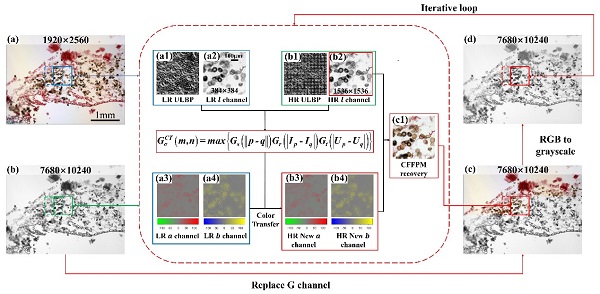Fourier ptychographic microscopy (FPM) is a promising computational imaging technique to realize high-throughput pathological imaging in medical diagnosis. However, existing FPM colorization approaches suffer from a trade-off between color precision and efficiency.
Therefore, a research team led by Associate Prof. PAN An, Prof. YAO Baoli and MA Caiwen from Xi’an Institute of Optics and Precision Mechanics (XIOPM) of the Chinese Academy of Sciences (CAS) reported a colorization method based on color-transfer filtering FPM (termed CFFPM).
The study was published in Photonics Research.
In a previous work, the team has reduced the runtime of full-color FPM by three-fold with negligible sacrifice on color precision through color-transfer FPM (termed CFPM).
On this basis, the study attempted to improve the ability to recover color information of samples stained by multiple dyes and reduce dependence on GPU acceleration.
The method integrates block processing and trilateral spatial filtering concepts into the transfer learning model of full-color FPM. In addition, an iterative procedure between two color spaces is adopted to refine the colorization results.
To make a comparison of color transfer performance and operating efficiency, the researchers tested several methods on a series of random selected samples.
Results showed that CFFPM provides more precise color transfer than CFPM, with the average error 3.5% lower. Without GPU (graphics processing unit) acceleration, the several minute time cost is significantly superior to CFPM with several hours. Also, CFFPM effectively eliminates the coherent artifacts introduced by dust particles.
Experts in this field believe that the reported method provides a turnkey solution for digital pathology via computational optical imaging due to its high-throughput advantage and low-cost hardware requirements.

Schematic diagram of CFFPM method. (Image by CHEN et al.)


